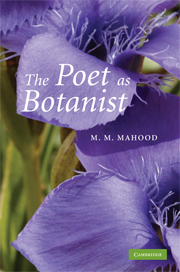Book contents
- Frontmatter
- Contents
- List of illustrations
- Acknowledgements
- A note on quotations
- Introduction
- 1 Primroses at Dove Cottage and Down House
- 2 Erasmus Darwin's feeling for the organism
- 3 Crabbe's slimy mallows and suffocated clover
- 4 John Clare: bard of the wild flowers
- 5 Ruskin's flowers of evil
- 6 D. H. Lawrence, botanist
- 7 Poetry and photosynthesis
- Index of persons
- Index of plants
6 - D. H. Lawrence, botanist
Published online by Cambridge University Press: 22 September 2009
- Frontmatter
- Contents
- List of illustrations
- Acknowledgements
- A note on quotations
- Introduction
- 1 Primroses at Dove Cottage and Down House
- 2 Erasmus Darwin's feeling for the organism
- 3 Crabbe's slimy mallows and suffocated clover
- 4 John Clare: bard of the wild flowers
- 5 Ruskin's flowers of evil
- 6 D. H. Lawrence, botanist
- 7 Poetry and photosynthesis
- Index of persons
- Index of plants
Summary
When D. H. Lawrence and Earl Brewster met in an olive grove, in a drift of poppies, the American thought Lawrence ‘looked like a man who lived devoted to the study of such life – a botanist’. This was remarkably perceptive. Lawrence had a lifelong interest in plants, and he is unique among major English writers in having studied botany as a university subject. In another way, though, Brewster was wide of the mark. What Lawrence devoted his writing life to was ‘the problem of today, the establishment of a new relation, or the re-adjustment of the old one, between men and women’. Every reader knows that he writes wonderfully about flowers, whether in his novels – the moonlit lilies in Sons and Lovers perhaps come first to mind – or in essays such as ‘Flowery Tuscany’, or in many poems of which ‘Bavarian Gentians’ is the most anthologised. But when Connie Chatterley and her lover deck each other's body hair with forget-me-nots, it is an odd reader (and a southerner into the bargain) who wonders how they have come by forget-me-nots in the middle of a wood – before remembering that there is a woodland species, Myosotis sylvatica, and that it grows abundantly in Derbyshire.
Is, then, the floweriness of Lawrence's fictional worlds – the 145 named species in his first novel, for instance – to be regarded simply as by-work? He did not himself think of it in this way.
- Type
- Chapter
- Information
- The Poet as Botanist , pp. 183 - 225Publisher: Cambridge University PressPrint publication year: 2008

